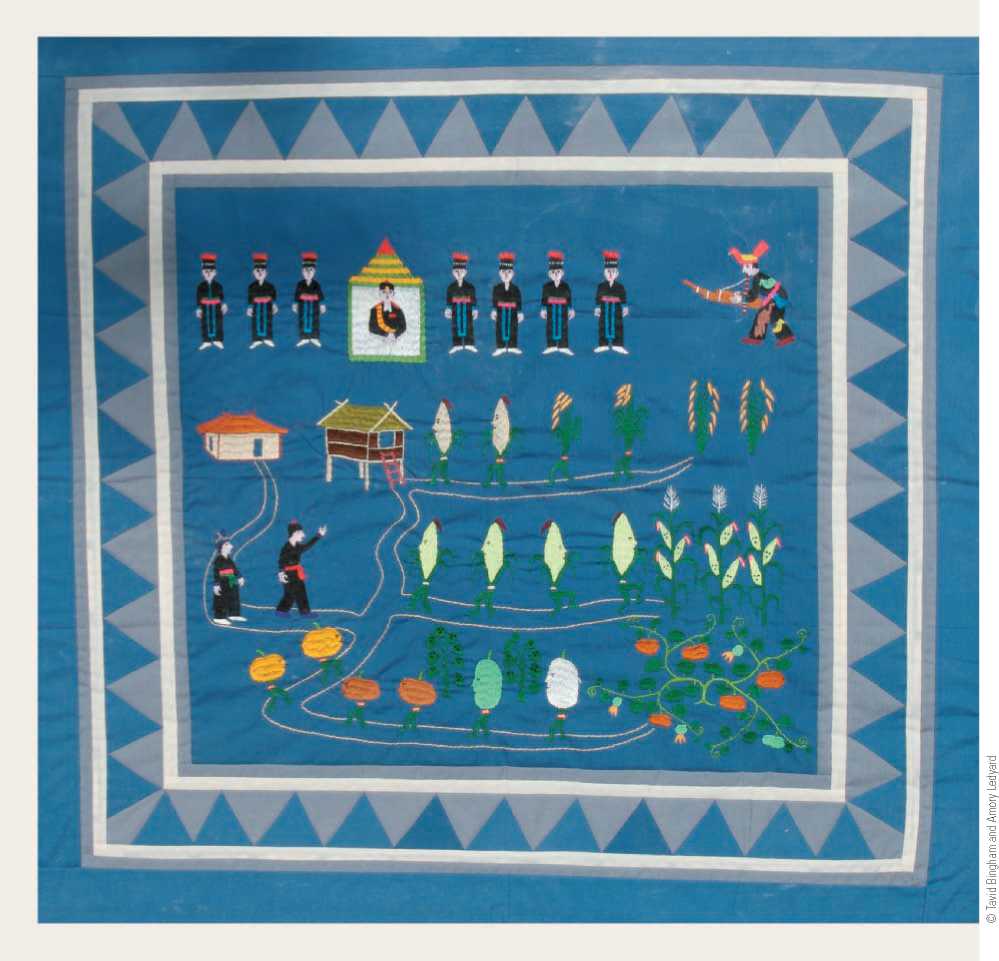As we look at the larger picture, since the time the genus Homo appeared, evolving humans came to rely increasingly on cultural, as opposed to biological, adaptation. To handle environmental challenges, evolving humans developed appropriate tools, clothes, shelter, use of fire, and so forth rather than relying upon biological adaptation of the human organism. This was true whether human
Paleoindians The earliest inhabitants of North America.
Biocultural Connection
Paleolithic Prescriptions for the Diseases of Civilization
Though increased life expectancy is often hailed as one of modern civilization's greatest accomplishments, in some ways we in the developed world lead far less healthy lifestyles than our ancestors. Throughout most of our evolutionary history, humans led more physically active lives and ate a more varied low-fat diet than we do now. Our ancestors did not drink or smoke. They spent their days scavenging or hunting for animal protein while gathering vegetable foods with some insects thrown in for good measure. They stayed fit through traveling great distances each day over the savannah and beyond.
Today we may survive longer, but in old age we are beset by chronic disease. Heart disease, diabetes, high blood pressure, and cancer shape the experience of old age in wealthy industrialized nations. The prevalence of these "diseases of civilization” has increased rapidly over the past sixty years. Anthropologists Melvin Konner and Marjorie Shostak and physician Boyd Eaton have suggested that our Paleolithic ancestors have provided a prescription for a cure. They propose that as "stone-agers in a fast lane,” people's health will improve by returning to the lifestyle to which their bodies are adapted.® Such Paleolithic prescriptions are an example of evolutionary medicine—a branch of medical anthropology that uses evolutionary principles to contribute to human health.
Evolutionary medicine bases its prescriptions on the idea that rates of cultural change exceed the rates of biological change. Our food-forager physiology was shaped over millions of years, while the cultural changes leading to contemporary lifestyles have occurred rapidly.
Anthropologists George Armelagos and Mark Nathan Cohen suggest that the downward trajectory for human health began with the earliest human village settlements some 10,000 years ago.175 176 When humans began farming rather than gathering, they often switched to single-crop diets. In addition, settlement into villages led directly to the increase in infectious disease. While the cultural invention of antibiotics has cured many infectious diseases, it also led to the increase in chronic diseases.
Our evolutionary history offers clues about the diet and lifestyle to which our bodies evolved. By returning to our ancient lifeways, we can make the diseases of civilization a thing of the past.
BIOCULTURAL QUESTION
What sort of Paleolithic prescriptions would our evolutionary history contribute toward behaviors such as childrearing practices, sleeping, and work patterns? Are there any ways that your culture or personal lifestyle is well aligned with past lifeways?
Populations lived in hot or cold, wet or dry, forest or grassland areas. Though culture is ultimately based on what might loosely be called brain power or, more formally, cognitive capacity, it is learned and not carried by genes. Therefore, cultural innovations may occur rapidly and can easily be transferred among individuals and groups.
Scientists have recently documented key differences in the proteins involved in brain metabolism in humans compared to other species that may account for some of this brain power. Unfortunately these metabolic changes are also associated with schizophrenia, indicating that there may have been some costs in the process. This study suggests that the cultural practice of cooking freed the body to devote more energy to brain metabolism.
While cooking was certainly an innovation of ancient Homo, the varied low-fat diet and high exercise of our ancestors were in general healthier than the dietary patterns prevailing in many parts of the world today. See this chapter’s Biocultural Connection for a discussion of how a return to the diets of our forebears may improve human health.
Cognitive capacity A broad concept including intelligence, educability, concept formation, self-awareness, self-evaluation,
Attention span, sensitivity in discrimination, and creativity.
Certain trends stand out from the information anthropologists have gathered about the Old Stone Age in most parts of the world. One was toward increasingly more sophisticated, varied, and specialized tool kits. Tools became progressively lighter and smaller, resulting in the conservation of raw materials and a better ratio between length of cutting edge and weight of stone. Tools became specialized according to region and function. Instead of crude all-purpose tools, more effective particularized devices were made to deal with the differing conditions of savannah, forest, and shore.
As humans came to rely increasingly on culture as a means to meet the challenges of existence, they were able to inhabit new environments. With more efficient tool technology, human population size could increase, allowing humans to spill over into more diverse environments. Improved cultural abilities may also have played a role in the reduction of heavy physical features, favoring instead decreased size and weight of face and teeth, the development of larger and more complex brains, and ultimately a reduction in body size and robustness. This dependence on intelligence rather than bulk provided the key for humans’ increased reliance on cultural rather than physical adaptation. The development of conceptual thought can be seen in symbolic artifacts and signs of ritual activity throughout the world.
Through Paleolithic times, at least in the colder parts of the world, hunting became more important, and people became more proficient at it. Humans’ intelligence enabled them to develop composite tools as well as the social organization and cooperation so important for survival and population growth. As discussed in the next chapter, this trend was reversed during the Mesolithic, when hunting lost its preeminence, and the gathering of wild plants and seafood became increasingly important.
As human populations grew and spread, cultural differences between regions also became more marked. While some indications of cultural contact and intercommunication are evident in the development of longdistance trade networks, tool assemblages developed in response to the specific challenges and resources of specific environments.
As Paleolithic peoples eventually spread over all the continents of the world, including Australia and the Americas, changes in climate and environment called for new kinds of adaptations. In forest environments, people needed tools for working wood; on the open savannah and plains, they came to use the bow and arrow to hunt the game they could not stalk closely; the people in settlements that grew up around lakes and along rivers and coasts developed harpoons and hooks; in the sub-Arctic regions, they needed tools to work the heavy skins of seals and caribou. The fact that culture is first and foremost a mechanism by which humans adapt means that as humans faced new challenges in the Paleolithic throughout the globe, their cultures differentiated regionally.
1. Upper Paleolithic art suggests that humans have always been challenged to understand where we fit in the larger system of life forms, past and present. What are your thoughts about how the impulse to create art relates to human efforts to make sense of our place in nature? What is your conception of the artist who might have made the Venus figurine in the chapter opening?
2. What does it mean to be “modern,” biologically or culturally? How should we define “human”?
3. How do you feel personally about the possibility of having Neandertals as part of your ancestry? How might you relate the Neandertal debates to stereotyping or racism in contemporary society?
4. Why do you think that most of the studies of prehistoric art have tended to focus on Europe? Do you think this focus reflects ethnocentrism or bias about the definition of art in Western cultures?
5. Do you think that gender has played a role in anthropological interpretations of the behavior of our ancestors and the way that paleoanthropologists and archaeologists conduct their research? Do you believe that feminism has a role to play in the interpretation of the past?
Clottes, J., & Bennett, G. (2002). World rock art (conservation and cultural heritage series). San Francisco: Getty Trust Publication.
Written by Jean Clottes, a leading authority on rock art (and discoverer of the Upper Paleolithic cave art site Grotte de Chauvet), this book provides excellent descriptions and beautiful images of rock art throughout the world, beginning with the earliest examples from Australia to rock art from the 20th century.
Dillehay, T. D. (2001). The settlement of the Americas. New York: Basic.
In an engaging, clear style, Dillehay provides a detailed account of the evidence from South America that has recently challenged theories about the peopling of the Americas, with particular emphasis on the author’s work in Chile.
Klein, R. (2002). The dawn of human culture. New York: Wiley. While this book covers the entire history of human evolution, it provides a particular focus on the theory of recent
African origins of the species Homo sapiens and associated cultural abilities.
White, R. (2003). Prehistoric art: The symbolic journey of humankind. New York: Abrams.
This sumptuously illustrated volume demonstrates the power of prehistoric imagery as well as providing a comprehensive overview of the theoretical approaches to studying prehistoric art. White presents a global survey of prehistoric art and demonstrates that Western notions of art have interfered with interpretations of prehistoric art.
Wolpoff, M., & Caspari, R. (1997). Race and human evolution: A fatal attraction. New York: Simon & Schuster.
This book is a detailed but readable presentation of the multiregional hypothesis of modern human origins. Among its strengths is a discussion of the problem of defining what “anatomically modern” means.

Challenge Issue This embroidery by Hmong artist Pangxiong Sirathasuk depicts not only her culture’s story of the origins of farming—a way of life that first began as early as 10,000 years ago— but also some of the consequences of this shift from food foraging to food production. According to Hmong folklore, the vegetables started out walking into villages. But they became disgusted with human greed and walked back to the fields, stating that humans in the future would have to work very hard to receive the earth’s bounty. Farming and the domestication of animals, along with settlement, mark the start of the Neolithic period. These cultural innovations solved some of the challenges of existence, but they also created new ones. Diets limited by reliance on single crops sometimes led to malnutrition and even famine when these crops failed. Crowded living conditions and close contact with animals in Neolithic villages promoted the spread of infectious disease. And as this embroidery shows, food production involves considerable labor. This artwork also demonstrates that the innovations from one part of the world disseminated globally. While the traditional Hmong homeland is in Southeast Asia, the pumpkins and corn depicted here are crops that were originally domesticated in the Americas. The development of permanent settlements and the domestication of animals and plants introduced new beliefs, daily routines, social relationships, and political structures that together continue to challenge humans globally.




 World History
World History









